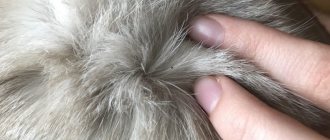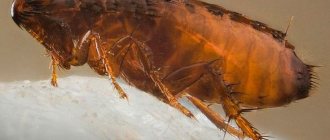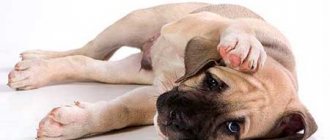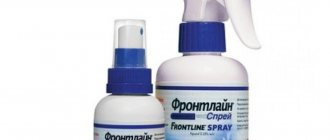Requirements for the product for skin application of spot-on against fleas
To choose the right drug for a kitten or adult animal, you need to consult a doctor. Spot-on facilities must meet the following requirements.
Efficiency.
The drops are really effective against most skin parasites. They help to quickly get rid of fleas without harming the animal.
Safety.
The “toxic” substances in the drugs only affect pests. They are practically safe for cats' health. But, like any medicine, spot-on drops have contraindications, so before using the product you should consult a specialist.
Versatility.
Spot-on products are suitable not only for the complete destruction of insects. The drug will prevent infection if you go with your pet to nature, becoming an excellent preventive measure. In addition, many products have a complex effect, also protecting against ticks, lice, lice, and some against intestinal parasites.
How can you tell if your cat has fleas or ticks?
If the cat is domestic, then it is extremely important to immediately notice that it has been attacked by blood-sucking parasites. Otherwise, they will not only move on to other animals living in the house, but will also damage the upholstery, linen and belongings of the owner. Therefore, if the following signs appear, you should either check the animal yourself for the presence of fleas, or take it to the veterinarian:
- The appearance of scratches, redness, protruding blood, irritation or inflammation on the skin;
- Detection of small dark spots in the fur, similar to dandruff;
- The fur lost its well-groomed appearance, stopped shining, and its loss became more frequent;
- The animal has become irritable, aggressive, and constantly itches.
It should be understood that even one flea that appears on a cat will not disappear by itself. Such parasites tend to multiply quickly, and they can also infect the animal with worms.
Signs of ticks in a cat are as follows:
- A significant increase in body temperature and, as a result, complete apathy, reluctance to leave your bedding and eat food;
- Dehydration and sudden weight loss;
- Vomiting and diarrhea, accompanied by cough and shortness of breath;
- Yellowing of the skin;
- The mucous membranes turn from pink to gray or white;
- The hair begins to fall out and redness of the skin is observed in bare areas.
Advantages of using antiparasitic drugs in the form of drops
Why are drugs in drop format considered more convenient and effective?
- Performance. Usually one treatment is enough to completely rid the animal of parasites, and the drug begins to act a day after application.
- Does not require rinsing. After treatment, the cat will not need to be bathed, which minimizes stress for the animal.
- Convenient shape. A few drops are enough for protection, and where to apply flea drops to a cat is described in detail in the instructions for the drug. As a rule, this is the area of the neck between the back of the head and the shoulder blades.
- Recommended by veterinarians. Most doctors advise using anti-flea products in this format, citing convenience, effectiveness and safety. So this product is ideal for treating your pet against pests.
General Tips
Most cats that live a purely domestic life and never leave their home do not become infected with fleas, and therefore do not need treatment. If your cat cannot live within four walls and craves freedom, then the appearance of fleas is inevitable . And once they appear, then you need to get rid of them correctly. It is necessary to choose drugs carefully, for a long time and very seriously. Before self-medicating, it would be a good idea to go to a veterinary clinic and get a consultation. When choosing a medicine, your first priority should not be price and availability, but safety and effectiveness. Remember that the life of your pet is strictly in your hands, and under no circumstances should you skimp on it!
Source
Instructions for the owner
How to properly apply flea drops to a cat so as not to harm either the animal or yourself? There are several rules:
- Be sure to consult your doctor, read the instructions for the drug and find out the required dosage for the weight and age of the animal;
- take the cat in your arms or sit it next to you;
- spread the fur at the animal’s withers; long-haired cats can be parted with a comb;
- Apply the required dose of the product to the skin in small drops or a thin strip, but do not rub it into the skin. Do not allow the cat to lick itself until the product is completely absorbed!
Do not apply the product to the animal's skin if there are wounds or irritation. It is forbidden to treat small kittens with adult products; special, milder preparations are used for them.
Rules for applying drops to a cat
In order for the composition to act as effectively as possible, it is important to follow the rules of application. The process itself is quite simple. It is necessary to secure the animal so that it does not twitch during the process. After this, the fur on the neck and between the shoulder blades is pulled apart. The composition drips onto the skin. Ideally, it is better to hold the animal in your hands for a while and calm it down. Next, the process lies in the details:
- If you plan to wash the animal before the effect of the composition expires, you need to stop using it before bathing or carry out the hygiene procedure earlier.
- If the cat has a very thick undercoat and it is very difficult to reach the skin, some owners trim an inconspicuous area of fur with the utmost care. This will make processing much easier.
- If the animal was bathed with flea shampoo or treated with another composition, then it is necessary to maintain the time between medications. The duration of the break depends on the specific form of insecticide.
- In addition to the animal, its bed, the place where it lives, and toys should be treated with flea products. Afterwards, objects and surfaces are thoroughly washed or washed.
- If additional exposure is required, you should consult a veterinarian, as too frequent use of insecticides can lead to poisoning of the cat.
- After applying the product, it is important to ensure that the animal does not shake itself off for some time and does not try to paw into the treatment area. The latter is dangerous in the context of licking.
- If it is not possible to prevent licking, then you should put protective material in the form of a blanket or collar on the cat.
The composition is considered safe immediately after drying. But in no case can you “adjust” the absorption process with the same hairdryer. It pays to be patient here.
Spot-on (on the withers) flea products for cats
"Four with a tail" with a repellent effect.
The main active ingredients of the drug are natural essential oils, the smell of which is unpleasant to most arthropods. The duration of the repellent effect is up to three weeks in the case of ixodid ticks, in the case of fleas - up to eight weeks. Not for use in nursing cats and kittens under 8 weeks of age.
"Bars Forte" against fleas and ticks.
The product is based on fipronil and contains natural oils. Effectively fights not only against lice, lice, ticks and fleas, but also destroys their eggs and larvae. Protects against attacks by six-legged parasites for up to 2 months, and against ticks for up to 4 weeks.
"Bars Forte" against fleas and ticks for kittens.
A product based on fipronil and natural essential oils, indicated for use in kittens from 10 weeks of age. Gives a repellent effect, scares away insects. Helps fight lice, ticks, fleas, lice eaters. Protects against insect attacks for up to 2 months, against ticks for up to 4 weeks.
"Bars" against fleas and ticks for cats.
A fipronil-based product that effectively fights most types of skin and hair parasites. Approved for use in kittens from 8 weeks of age. The protective effect of the drug can reach 2 months, against ticks up to 1 month.
You can purchase these and other effective substances against fleas and other parasites in the official AVZ online store.
Contraindications for use
The drops pose the greatest danger to nursing cats with small kittens aged from birth to four months. A cat may perceive the drops on her children as an attempt to wean them from their mother, and will begin to lick them profusely, which can lead to severe poisoning.
Also, small kittens, while playing, can accidentally bite each other and also “eat” substances harmful to their fragile organisms. A healthy adult cat in such a situation may simply feel unwell and not touch food for several days.
There are cases when insecticides can cause allergies in a cat, hair loss at the site of application of the drops, and even dermatitis. However, these cases are extremely rare, and before use, you should apply a small amount of the product to the paw or side of the animal's body to check the reaction.
But for fleas, the drops pose a mortal danger. Most parasites die instantly as soon as they come into contact with the place where the drops are smeared . The rest immediately run away from the cat’s body, wanting to hide from the unpleasant smell as soon as possible. If you have rid your cat of fleas, and you have a budgie, then a flea can easily settle on the bird. Read about treating parrots for these parasites here.
What blogs look like in a cat's fur
List of eye drops for allergies
| Drug name | Age | Price in pharmacies | |
| Antihistamines | |||
| Allergodil | from 6 years old | 700 rubles | |
| Visallergol | from 8 years old | 650 rubles | |
| Opatanol | from 3 years old | 600 rubles | |
| Mast cell blockers | |||
| Lecrolin | from 4 years old | 120 rubles | |
| Cromohexal | from 5 years old | 170 rubles | |
| Cromicil | from 5 years old | 100 rubles | |
| Glucocorticosteroids (GCS) | |||
| Dexamethasone | from 18 years old | 120 rubles | |
| Maxidex | no data | 450 rubles | |
| Hydrocortisone | from 18 years old | 170 rubles | |
| Nonsteroidal anti-inflammatory drugs (NSAIDs) | |||
| Indocollier | from 18 years old | 550 rubles | |
| Diclofenac | from 2 years | 60 rubles | |
| Diklo-F | from 18 years old | 150 rubles | |
| Moisturizing drops (tear substitutes) | |||
| Cationorm | from 0 years | 650 rubles | |
| Okutiarz | No data | 720 rubles | |
| Oftagel | from 0 years | 350 rubles | |
Material prepared by: Sagonenko Dmitry Alekseevich
Ophthalmologist, site consultant
Why fleas are dangerous for a pregnant cat and newborn kittens
A flea is a blood-sucking insect that is a carrier of diseases, helminths, and poses a particular danger to kittens that have just been born. Removing them from a pregnant cat is very problematic.
At the first signs of anxiety and active scratching, an attentive owner realizes that the cat has fleas. By biting through the delicate skin, they irritate it with their saliva, causing redness and itching; the animal begins to scratch the bite site, tearing out the fur with its claws, leaving significant wounds.
Removing fleas from an adult cat is very simple, but if it comes to a pregnant cat, you need to be very careful when choosing drops and anti-flea products.
Fleas
If you decide that the cat is ready to give birth to kittens and have selected a suitable candidate for her, it is necessary to carry out deworming and wear a flea collar to prevent the accidental transmission of insects from the cat. Fleas, like helminths, pose a great danger to a pregnant cat and her babies.
After birth, parasites immediately attack tiny kittens, bite, causing severe pain, itching, and lead to skin irritation. Subsequently, they become infected with helminths. Kittens that suffer from parasites from birth are very weak, develop slowly, eat poorly, and gain weight. Therefore, it is imperative to treat fleas on a nursing cat!
Precautionary measures
- Although celandine drops are not overly toxic, it is still poison, so the following safety precautions must be observed when using the drug.
- The person performing the procedure on the cat must wear special gloves that protect the skin of their hands.
- Avoid contact of the drug with the eyes or any other mucous membranes of both yourself and your pet.
- To protect yourself from celandine entering the body, you should not eat, smoke or drink during the procedure.
- If the drug is ingested, gastric lavage should be performed.
- After the procedure, it is enough to wash your hands with soap or disinfect them.
- An empty container of celandine must be disposed of.
How to use correctly
Stronghold is applied to the skin of the withers (lower part of the neck) monthly. To open a plastic pipette, hold it upright and push down on the cap until the small tip on the cap breaks the seal on the pipette. Part the fur and squeeze the entire contents of the dropper onto the skin just above the shoulder blades, where your pet won't be able to lick it off.
Stronghold is available in a variety of package sizes so that dogs and cats of varying weights can be dosed accordingly.
Each Stronghold size is color coded on the packaging for easy identification. A summary of how much of the drug is required for different sizes of dogs and cats is given in the table below.
At what age can drops be used?
Fleas are external parasites of pets. Flea bites are very itchy and can cause allergies and dermatitis in the animal. If your pet is left untreated, its fur may fall out. The body becomes vulnerable to worms and various infections. Flea infestation leads to the development of anemia, which often ends in death.
The cat is itching
A kitten can become infected immediately after birth. This occurs if the mother was not treated before pregnancy. Babies can be treated from the age of 3 months.
Before reaching this age, fleas are removed by hand, the kittens are bathed with a mild shampoo, making sure that it does not get into the baby’s eyes, mouth and nose. After bathing, you need to dry the coat with a hairdryer. Do not allow the kitten into a cold, drafty room for 8–10 hours. By licking newborns, the cat removes some of the fleas. It is advisable to wash the bed on which the cat family sleeps every day. You can comb babies with a small soft comb.
The drops are intended for kittens at least six months old. In pet stores and veterinary pharmacies you can find special gentle drops for babies, but they also should not be used before babies are 12 weeks old.
Important! Products such as spray, special collar, powder, and aerosol are not suitable for children. Moreover, if you put a collar on a kitten too early, this can lead to stunted growth and development of the pet.
Kitten after bathing
Types of eye allergies
There are a wide variety of forms of eye allergies, the most common of which are allergic dermatitis and conjunctivitis. But it should be noted that an allergic reaction can affect all structures of the eye and cause damage to them, for example, keratitis (inflammation of the cornea), papilledema, uveitis, etc. An allergic process in the eyes or eyelids can be either an independent disease (a reaction to the ingestion of cosmetics, medications, or be a manifestation of a systemic disease (hay fever, etc.).[1]
Fig. 1 Manifestation of allergies in the eyes: conjunctivitis, blepharitis and their combination (blepharoconjunctivitis)











